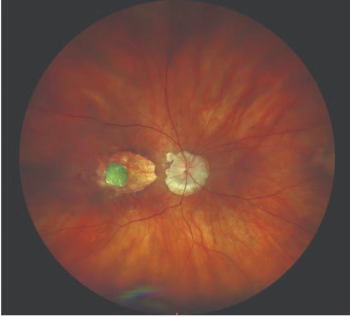
Sustained drug-delivery technologies shape promising future
Development of technologies for sustained drug delivery is a topic of great interest among retina specialists considering the number of chronic conditions that are managed with repeated intravitreal injections.
Development of technologies for sustained drug delivery is a topic of great interest among retina specialists considering the number of chronic conditions that are managed with repeated intravitreal injections.
Products in this category are already available, and several novel implants are being developed that have shown positive results in clinical trials.
“The future for sustained intravitreal drug delivery looks bright,” said Glenn J. Jaffe, MD, Robert Machemer Professor of Ophthalmology, Duke University Eye Center, Durham, NC, in an update during the Retina Subspecialty Day meeting.
“Innovation occurring in this field shows promise to provide ophthalmologists with access to implants that can be inserted in an office setting and that are adaptable to use with virtually any therapeutic agent,” he said. “Furthermore, the sustained-delivery system release characteristics can be tailored for a particular disease.”
Current options
The available intravitreal sustained-release, drug-delivery systems represent both non-biodegradable and biodegradable platforms.
Nonbiodegradable implants incorporate a drug reservoir that is released in a linear fashion over time while the implant itself, which is made of a non-toxic, biocompatible material, remains unchanged, and is either exchanged or left in the eye when the drug load is exhausted.
This type of system is found in the surgically placed fluocinolone acetonide implant 0.59 mg (Retisert, Bausch + Lomb), which is approved for treatment of chronic non-infectious uveitis affecting the posterior segment, and in the injectable fluocinolone acetonide implant 0.19 mg (Iluvien, Alimera Sciences), which is approved for the treatment of diabetic macular edema (DME).
“The benefit of the non-biodegradable implants is the ability to deliver medication for a period of years rather than just weeks to months,” Dr. Jaffe said.
In a biodegradable system, which is used for the injectable dexamethasone 0.7 mg implant (Ozurdex, Allergan), the implant degrades as drug is released. The dexamethasone implant is approved for the treatment of DME, non-infectious uveitis affecting the posterior segment, and macular edema following branch or central retinal vein occlusion, and lasts up to 6 months, but usually slightly less.
“Compared with the non-biodegradable implants, the biodegradable system provides drug for only weeks to months, but not years,” Dr. Jaffe said.
Future developments
Investigational sustained-delivery platforms being developed for treatment of retinal diseases include cell-based systems, refillable implants, and injectable implants.
Cell-based systems incorporate genetically engineered cells producing a protein of interest that is released into the vitreous cavity through a semi-permeable membrane. The semi-permeable membrane impedes penetration by immune system cells, thereby mitigating the potential for a host immune response to the foreign protein.
This type of technology is found in NT-501 Ciliary Neurotrophic Factor Encapsulated Cell Therapy (Neurotech) that is being developed for the treatment of macular telangiectasia type 2. Currently, a phase III trial investigating NT-501 for macular telangiectasia type 2 is under way after results of a phase II trial showed it significantly reduced the progressive loss of photoreceptors compared with sham.
Implantable refillable implants can be replenished with the active product and are being looked at for multiple indications, including glaucoma, age-related macular degeneration, DME, and uveitis.
Several different types of this system are being developed, including an electromechanical pump reservoir system for which the rate of drug release can be varied.
Developed by Mark Humayun, MD, PhD, the replenishable micropump loaded with ranibizumab was tested in a phase I study in which it was implanted into the subconjunctival space in 11 eyes of patients with DME.
The results were promising in terms of outcomes that assessed release characteristics and biological activity. In four of the 11 eyes enrolled, the device did not function properly, presumably because it was damaged during implantation, but that issue has been addressed, Dr. Jaffe said.
The rigid port delivery system is another refillable system that is being developed by Genentech. It is inserted into the vitreous with standard surgical techniques through a scleral incision in a one-time surgical procedure, but its port remains outside the sclera for ease of refilling in an office procedure.
A phase II trial (LADDER) is now under way investigating use of a ranibizumab port delivery system for treatment of patients with subfoveal neovascular AMD.
Expanding indication
An investigational injectable fluocinolone acetonide intravitreal insert 0.18 mg is being evaluated in two phase III trials as treatment for chronic non-infectious uveitis affecting the posterior segment.
Previous to their launch, Dr. Jaffe initiated a single-center study evaluating low- and high-dose injectable fluocinolone acetonide implants to treat eyes with noninfectious intermediate uveitis, posterior uveitis, or panuveitis. It included 11 patients who were followed for 2 years. The results showed the implant was very effective for controlling inflammation, decreasing the need for adjunctive therapy, and improving visual acuity. The treatment had an acceptable side effect profile.
“Favorable results have been reported from the phase III trials after 12 months of follow-up, and hopefully, this product will be approved for treatment of uveitis,” Dr. Jaffe said.
Dr. Jaffe is a consultant for pSivida.
Newsletter
Keep your retina practice on the forefront—subscribe for expert analysis and emerging trends in retinal disease management.












































